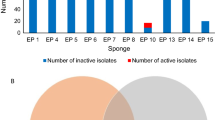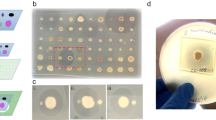Abstract
Microbial competition for limiting natural resources within a community is thought to be the selective force that promotes biosynthesis of antimicrobial compounds The marine bacterium Streptomyces tenjimariensis produces the antibiotics istamycin A and B under select laboratory culture conditions; presumably these compounds serve an, ecological role under natural conditions. Here we report results of a novel marine microbial competion experiment that examined the impact of co-culture of marine bacteria on istamycin production by S. tenjimariensis. Twelve of the 53 bacterial species tested (i.e., 22.6%) induced Istamycin production; this antibiotic also inhibited growth of the competitor colonies. These results suggest that marine bacterial metabolites, serve an ecological role in countering competitive species.
Similar content being viewed by others
References
Acar JF (1980) The disc susceptibility test. In: Lorian V (ed) Antibiotics in Laboratory Medicine. Williams & Wilkens, London, pp 24–54
Adams J, Kinney T, Thompson S, Rubin L, Helling RB (1979) Frequency dependent selection for plasmid containing cells of Eschrichia coli. Genetics 91:627–637
Alexander M (1977) Introduction to Soil Microbiology John Wiley, New York, pp
Bachofen R, Schenk A (1998) Quorum, sensing autoinducers: do they play a role in natural microbial habitats? Microbiol Res 153:61–63
Brian PW (1957) The ecological significance of antibiotic production. Symp Soc. Gen Microbiol 7:168–188
Fenical W (1993) Chemical studies of marine bacteria: developing a new resource. Chem. Rev. 93:1673–1683
Gray KM (1997) Intercellular communication and group behavior in bacteria. Trends Microbiol 5:184–188 DOI: 10.1016/S0966-842X(97)01002-0
Harder W, Kuenen JG (1977) Microbial selection in continuous culture. J Appl Bacteriol 43:1–24
Hotta K, Yoshida M, Hamada M, Okami Y (1980) Studies on new aminoglycoside antibiotics, Istamycins, from an actinomycete isolated from a marine environment. III. Nutritional effects on Istamycin production and additional chemical and biological properties of Istamycins. J Antibiotics 33:1515–1520
Howie WJ, Suslow TV (1991) Role of antibiotic biosynthesis in the inhibition of Pythium ultimum in the cotton spermoshere and rhizosphere by Pseudomonas fluorescens. Mol Plant-Microbe Interact 4:393–399
Ikeda D, Horiuchi Y, Yoshida M, Miyasaka T, Kondo S, Umezawa H (1982) Isolation and structures of Istamycin components. Carbo Res 109:33–45
Iwasa Y, Nakamaru M, Levin SA (1998) Allelopathy of bacteria in a lattice population: competition between colicinsensitive and colicin-producing strains. Evol Ecol 12:785–802
Liberra K, Lindequist U (1995) Marine fungi—a prolific resource of biologically active natural products? Pharmazie 50:583–588
Okami Y, Hotta K, Yoshida M, Ikeda D, Kondo S, Umezawa H (1979) New aminoglycoside antibiotics, Istamycins A and B, J Antibiotics 32:964–966
Paul VJ (ed) (1992) Ecological Roles of Marine Natural Products. Cornell University Press, Ithaca, NY, pp
Rasool K, Wimpenny JWT (1983) Mixed continuous culture experiments with an antibiotic-producing streptomycete and Escherichia coli. Microbiol Ecol 8:267–277
Roughley RJ, Wahab FA, Sundram J (1992) Intrinsic resistance to streptomycin and streptinomycin among root-nodule bacteria from Malaysian soils. Soil Biol Biochem 24:715–716
Slattery M, McClintock JB, Heine J (1995) Chemical defenses in Antarctic soft corals: evidence for antifouling compounds. J Exp Mar Biol Ecol 190:61–78 DOI: 10.1016/0022-0981(95)00032-M
Smith HL (1981) Competitive coexsistence in an oscillating chemostat. SIAM J Appl Math 40:498–522
Turpin PE, Dhir VK, Maycroft KA, Rowlands C, Wellington EMH (1992) The effect of Streptomyces species on the survival of Salmonella in soil. FEMS Microbiol Ecol 100:271–280
Waksman SA (1961) The role of antibiotics in nature. Perspect Biol Med 4:271–287
Weiner P (1996) Experimental studies on the ecological role of antibiotic production in bacteria. Evol Ecol 10:405–421
Wesson KJ, Kuhajek JM, Warren M, Puglisi MP, Dunbar DC, Slattery M (1997) Biomedical compounds from marine and terrestrial microbes: the influence of nutrition on bioactivity. 38th Mtg. American Society of Pharmacognosy, Iowa City, IA, 26–30 July 1997 (abstract only)
Williams ST (1982) Are antibiotics produced in soil? Pedobiologia 23:427–435
ZoBell CE (1941) Studies on marine bacteria. I. The cultural requirements of heterotrophic aerobes. J Mar Res 4:42–75
Author information
Authors and Affiliations
Corresponding author
Rights and permissions
About this article
Cite this article
Slattery, M., Rajbhandari, I. & Wesson, K. Competition-mediated antibiotic induction in the marine bacterium Streptomyces tenjimariensis . Microb Ecol 41, 90–96 (2001). https://doi.org/10.1007/s002480000084
Received:
Accepted:
Issue Date:
DOI: https://doi.org/10.1007/s002480000084




